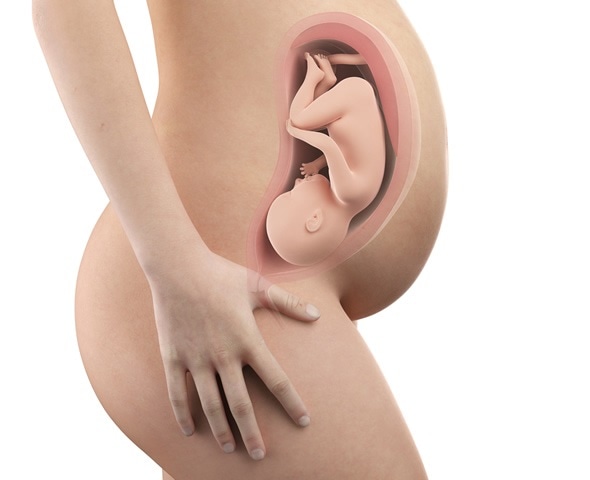By this late stage of pregnancy, the baby’s nervous system is fully developed. Aside from the skull bones, other bones in the body are hardening.
The skull bones remain separated and soft until after the baby has been born. This is because the bones need to be flexible enough to slide across each other so that the brain is protected while the baby makes the journey through the birth canal.
From around this period, the mother will experience “practice” contractions, referred to as Braxton Hicks, which prepares the uterus for the contractions that will occur during labor.
Space in the uterus is restricted and there is little room for the baby to move, although the mother will still feel some movements or see signs of them on the surface of her abdomen.
By the 36th week, the lungs are fully developed and prepared for the first breath that will be taken outside of the body. The baby is now able to suckle and feed and the digestive system is ready to handle breast milk.
Week 33
From week 33 onwards, it is likely that the baby will become settled in a certain position.
By this stage, babies are usually in the head down or cephalic position, but there is not yet cause for concern if the baby is not in this position because there is still time for it to turn.
The baby’s sleeping and waking periods are generally regular now, with most of the time spent sleeping.
The baby alternates between periods of increased brain activity during rapid eye movement (REM) sleep and longer periods of more relaxed non-REM sleep.
Week 34
By the 34th week of pregnancy, the digestive and intestinal systems are fully developed and functioning.

Medical accurate 3d illustration of a fetus week 34. Image Copyright: Sebastian Kaulitzki / Shutterstock
The first stool, referred to as the meconium stool, is now present in the baby’s gut and will be excreted once the baby is born. The mother may experience Braxton Hicks contractions at around this time.
The contractions do not usually hurt, but a mother may need to contact her midwife or the hospital if the contractions start to become frequent or painful.
Week 35
By the 35th week, the baby’s limbs have become plump and the baby will gain approximately 1/2 pound every week for the next month.
The baby’s movements may be significantly reduced, since space is much more restricted in the womb now. The mother is more likely to feel movement as a light wriggle or squirm rather than an obvious kick.
The layer of fine soft hair (lanugo) that had previously been covering and protecting the baby’s skin has now disappeared completely and the baby’s fat stores are now providing the necessary insulation.
Week 36
During the 36th week of pregnancy, the baby is still gaining weight and will soon accommodate almost all of the space in the uterus.

Pregnant woman with visible uterus and fetus week 36. Image Copyright: Sebastian Kaulitzki / Shutterstock
Babies born at this stage are usually small, although healthy overall, so mothers should try not to be concerned if they start to go into labor during this week.
Further Reading